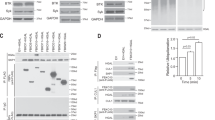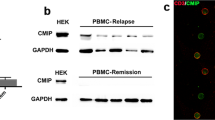Abstract
The adaptor molecule, linker for activation of T cells (LAT), is essential in T cell activation and development; a similar molecule in B cells has not yet been identified. Here, we report the identification of a new adaptor protein, linker for activation of B cells (LAB). Like LAT, LAB was localized to lipid rafts. Upon activation via the B cell receptor (BCR), LAB was phosphorylated and interacted with the adaptor protein Grb2. Decreased LAB expression led to a reduction in BCR-mediated calcium flux and Erk activation. LAB rescued thymocyte development but not normal T cell activation in LAT−/− mice. Our data suggest that LAB links BCR engagement to downstream signaling pathways.
This is a preview of subscription content, access via your institution
Access options
Subscribe to this journal
Receive 12 print issues and online access
$209.00 per year
only $17.42 per issue
Buy this article
- Purchase on Springer Link
- Instant access to full article PDF
Prices may be subject to local taxes which are calculated during checkout








Similar content being viewed by others
References
Reth, M. & Wienands, J. Initiation and processing of signals from the B cell antigen receptor. Annu. Rev. Immunol. 15, 453–479 (1997).
DeFranco, A.L. The complexity of signaling pathways activated by the BCR. Curr. Opin. Immunol. 9, 296–308 (1997).
Tamir, I. & Cambier, J.C. Antigen receptor signaling: integration of protein tyrosine kinase functions. Oncogene 17, 1353–1364 (1998).
Schaeffer, E.M. & Schwartzberg, P.L. Tec family kinases in lymphocyte signaling and function. Curr. Opin. Immunol. 12, 282–288 (2000).
Kurosaki, T. Functional dissection of BCR signaling pathways. Curr. Opin. Immunol. 12, 276–281 (2000).
Conley, M.E., Rohrer, J., Rapalus, L., Boylin, E.C. & Minegishi, Y. Defects in early B-cell development: comparing the consequences of abnormalities in pre-BCR signaling in the human and the mouse. Immunol. Rev. 178, 75–90 (2000).
Zhang, W., Sloan-Lancaster, J., Kitchen, J., Trible, R.P. & Samelson, L.E. LAT: the ZAP-70 tyrosine kinase substrate that links T cell receptor to cellular activation. Cell 92, 83–92 (1998).
Finco, T.S., Kadlecek, T., Zhang, W., Samelson, L.E. & Weiss, A. LAT is required for TCR-mediated activation of PLCγ1 and the Ras pathway. Immunity 9, 617–626 (1998).
Zhang, W., Irvin, B.J., Trible, R.P., Abraham, R.T. & Samelson, L.E. Functional analysis of LAT in TCR-mediated signaling pathways using a LAT-deficient Jurkat cell line. Int. Immunol. 11, 943–950 (1999).
Zhang, W. et al. Essential role of LAT in T cell development. Immunity 10, 323–332 (1999).
Fu, C., Turck, C.W., Kurosaki, T. & Chan, A.C. BLNK: a central linker protein in B cell activation. Immunity 9, 93–103 (1998).
Wienands, J. et al. SLP-65: a new signaling component in B lymphocytes which requires expression of the antigen receptor for phosphorylation. J. Exp. Med. 188, 791–795 (1998).
Goitsuka, R. et al. BASH, a novel signaling molecule preferentially expressed in B cells of the bursa of Fabricius. J. Immunol. 161, 5804–5808 (1998).
Pappu, R. et al. Requirement for B cell linker protein (BLNK) in B cell development. Science 286, 1949–1954 (1999).
Ishiai, M. et al. BLNK required for coupling Syk to PLC γ 2 and Rac1-JNK in B cells. Immunity 10, 117–125 (1999).
Minegishi, Y. et al. An essential role for BLNK in human B cell development. Science 286, 1954–1957 (1999).
Zhang, W., Trible, R.P. & Samelson, L.E. LAT palmitoylation: its essential role in membrane microdomain targeting and tyrosine phosphorylation during T cell activation. Immunity 9, 239–246 (1998).
Doyle, J.L., DeSilva, U., Miller, W. & Green, E.D. Divergent human and mouse orthologs of a novel gene (WBSCR15/Wbscr15) reside within the genomic interval commonly deleted in Williams syndrome. Cytogenet. Cell Genet. 90, 285–290 (2000).
Zhang, W. et al. Association of Grb2, Gads, and phospholipase C-γ 1 with phosphorylated LAT tyrosine residues: effect of LAT tyrosine mutations on T cell antigen receptor-mediated signaling. J. Biol. Chem. 275, 23355–23361 (2000).
Liu, S.K., Fang, N., Koretzky, G.A. & McGlade, C.J. The hematopoietic-specific adaptor protein gads functions in T-cell signaling via interactions with the SLP-76 and LAT adaptors. Curr. Biol. 9, 67–75 (1999).
Chan, A.C. et al. Activation of ZAP-70 kinase activity by phosphorylation of tyrosine 493 is required for lymphocyte antigen receptor function. EMBO J. 14, 2499–2508 (1995).
Sharp, P.A. RNAi and double-strand RNA. Genes Dev. 13, 139–141 (1999).
Elbashir, S.M., Lendeckel, W. & Tuschl, T. RNA interference is mediated by 21- and 22-nucleotide RNAs. Genes Dev. 15, 188–200 (2001).
Elbashir, S.M. et al. Duplexes of 21-nucleotide RNAs mediate RNA interference in cultured mammalian cells. Nature 411, 494–498 (2001).
Yu, J.Y., DeRuiter, S.L. & Turner, D.L. RNA interference by expression of short-interfering RNAs and hairpin RNAs in mammalian cells. Proc. Natl. Acad. Sci. USA 99, 6047–6052 (2002).
Pierce, S.K. Lipid rafts and B-cell activation. Nat. Rev. Immunol. 2, 96–105 (2002).
Cheng, P.C., Dykstra, M.L., Mitchell, R.N. & Pierce, S.K. A role for lipid rafts in B cell antigen receptor signaling and antigen targeting. J. Exp. Med. 190, 1549–1560 (1999).
Fujimoto, M., Poe, J.C., Inaoki, M. & Tedder, T.F. CD19 regulates B lymphocyte responses to transmembrane signals. Semin. Immunol. 10, 267–277 (1998).
Cherukuri, A., Dykstra, M. & Pierce, S.K. Floating the raft hypothesis: Lipid rafts play a role in immune cell activation. Immunity 14, 657–660. (2001).
Zipfel, P.A. et al. The c-Abl tyrosine kinase is regulated downstream of the B cell antigen receptor and interacts with CD19. J. Immunol. 165, 6872–6879 (2000).
Engels, N., Wollscheid, B. & Wienands, J. Association of SLP-65/BLNK with the B cell antigen receptor through a non-ITAM tyrosine of Ig-α. Eur. J. Immunol. 31, 2126–2134 (2001).
Wong, J., Ishiai, M., Kurosaki, T. & Chan, A.C. Functional complementation of BLNK by SLP-76 and LAT linker proteins. J. Biol. Chem. 275, 33116–33122 (2000).
Zhu, M., Janssen, E. & Zhang, W. Minimal requirement of tyrosine residues of LAT (linker for activation of T cells) in TCR signaling and thymocyte development. J. Immunol. 17, 325–333 (2003).
Acknowledgements
We thank the Duke University Cancer Center Flow Cytometry and Sequencing facilities. This work is supported by National Institutes of Health Grant 1R01 AI48674-01.
Author information
Authors and Affiliations
Corresponding author
Ethics declarations
Competing interests
The authors declare no competing financial interests.
Supplementary information
Rights and permissions
About this article
Cite this article
Janssen, E., Zhu, M., Zhang, W. et al. LAB: A new membrane-associated adaptor molecule in B cell activation. Nat Immunol 4, 117–123 (2003). https://doi.org/10.1038/ni882
Received:
Accepted:
Published:
Issue Date:
DOI: https://doi.org/10.1038/ni882
This article is cited by
-
NTAL is associated with treatment outcome, cell proliferation and differentiation in acute promyelocytic leukemia
Scientific Reports (2020)
-
One-way membrane trafficking of SOS in receptor-triggered Ras activation
Nature Structural & Molecular Biology (2016)
-
The HDAC class I-specific inhibitor entinostat (MS-275) effectively relieves epigenetic silencing of the LAT2 gene mediated by AML1/ETO
Oncogene (2011)
-
A tale of two TRAPs: LAT and LAB in the regulation of lymphocyte development, activation, and autoimmunity
Immunologic Research (2011)
-
Syk
AfCS-Nature Molecule Pages (2007)



